Applying Social Media Marketing Concepts in the Agribusiness Sector
VerifiedAdded on 2020/03/23
|10
|3074
|86
Report
AI Summary
This report delves into the application of social media marketing concepts within the agribusiness sector, using Bayer and Monsanto as illustrative examples. It explores the shift in communication methods driven by technological advancements and the increasing diversification of agriculture. The report examines various approaches to social media marketing, including setting concrete goals, establishing creative social teams, and defining site guidelines. It also discusses the determinants of successful social media usage, such as legal factors, limitations on effectiveness, cost considerations, and the importance of establishing trust and human connections. Furthermore, it analyzes the advantages and disadvantages of social media marketing, including audience reach, free creation, encouragement of sharing, increased brand loyalty, and the potential for negative feedback and time-intensive management. The report highlights the roles of social media in agribusiness, focusing on consumer engagement, industry knowledge, and calibration across regions, emphasizing the importance of social media in connecting farmers, industries, and consumers and supporting the value chain in the agricultural sector. The report emphasizes the significance of social media as a crucial marketing tool for agribusiness, enabling companies to interact with clients and expand their reach in the global market.
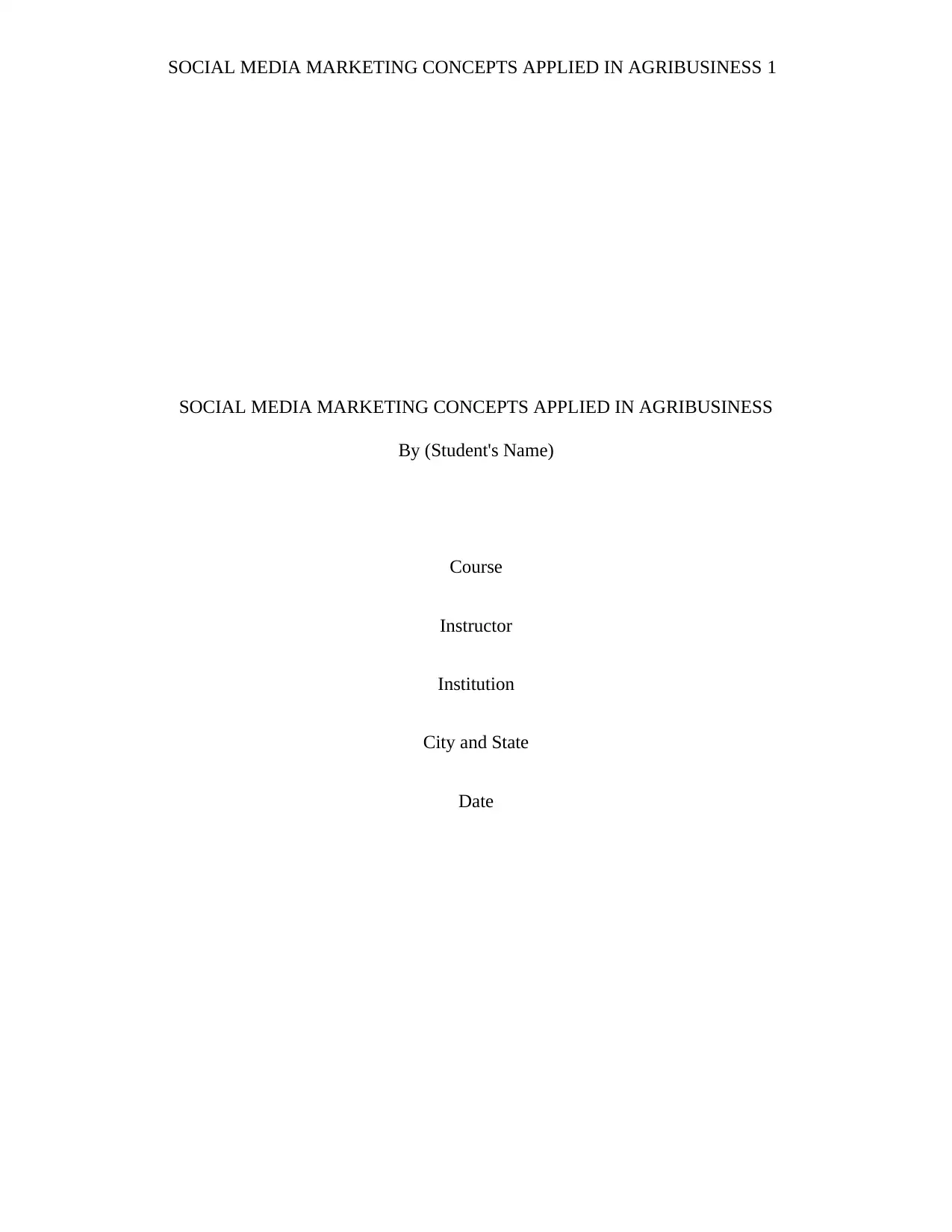
SOCIAL MEDIA MARKETING CONCEPTS APPLIED IN AGRIBUSINESS 1
SOCIAL MEDIA MARKETING CONCEPTS APPLIED IN AGRIBUSINESS
By (Student's Name)
Course
Instructor
Institution
City and State
Date
SOCIAL MEDIA MARKETING CONCEPTS APPLIED IN AGRIBUSINESS
By (Student's Name)
Course
Instructor
Institution
City and State
Date
Paraphrase This Document
Need a fresh take? Get an instant paraphrase of this document with our AI Paraphraser

SOCIAL MEDIA MARKETING CONCEPTS APPLIED IN AGRIBUSINESS 2
Contents
Introduction....................................................................................................................................................2
Social media sites...........................................................................................................................................2
Approaches to social media marketing in agribusiness.................................................................................3
Setting concrete goals................................................................................................................................3
Creative social team...................................................................................................................................3
Setting site guidelines................................................................................................................................3
Determinants of successful social media usage in agribusiness................................................................4
The legal factors.........................................................................................................................................4
Limitations on effectiveness......................................................................................................................4
Cost considerations....................................................................................................................................4
Establishing trust and human connections.................................................................................................4
Oversight of user content...........................................................................................................................4
Advantages and disadvantages of social media marketing............................................................................5
Social media marketing advantages...........................................................................................................5
Large audience reach.............................................................................................................................5
Free creation...........................................................................................................................................5
Encourages sharing................................................................................................................................5
Increased brand loyalty..........................................................................................................................5
Unveils valuable insights.......................................................................................................................5
Social media marketing disadvantages......................................................................................................6
Negative feedback..................................................................................................................................6
Potential tool for embarrassment...........................................................................................................6
Time intensive........................................................................................................................................6
Roles of social media in agribusiness............................................................................................................6
Consumer engagement...............................................................................................................................7
Industry knowledge and trends..................................................................................................................7
Calibration across regions..........................................................................................................................7
Conclusion.....................................................................................................................................................7
References......................................................................................................................................................8
Contents
Introduction....................................................................................................................................................2
Social media sites...........................................................................................................................................2
Approaches to social media marketing in agribusiness.................................................................................3
Setting concrete goals................................................................................................................................3
Creative social team...................................................................................................................................3
Setting site guidelines................................................................................................................................3
Determinants of successful social media usage in agribusiness................................................................4
The legal factors.........................................................................................................................................4
Limitations on effectiveness......................................................................................................................4
Cost considerations....................................................................................................................................4
Establishing trust and human connections.................................................................................................4
Oversight of user content...........................................................................................................................4
Advantages and disadvantages of social media marketing............................................................................5
Social media marketing advantages...........................................................................................................5
Large audience reach.............................................................................................................................5
Free creation...........................................................................................................................................5
Encourages sharing................................................................................................................................5
Increased brand loyalty..........................................................................................................................5
Unveils valuable insights.......................................................................................................................5
Social media marketing disadvantages......................................................................................................6
Negative feedback..................................................................................................................................6
Potential tool for embarrassment...........................................................................................................6
Time intensive........................................................................................................................................6
Roles of social media in agribusiness............................................................................................................6
Consumer engagement...............................................................................................................................7
Industry knowledge and trends..................................................................................................................7
Calibration across regions..........................................................................................................................7
Conclusion.....................................................................................................................................................7
References......................................................................................................................................................8
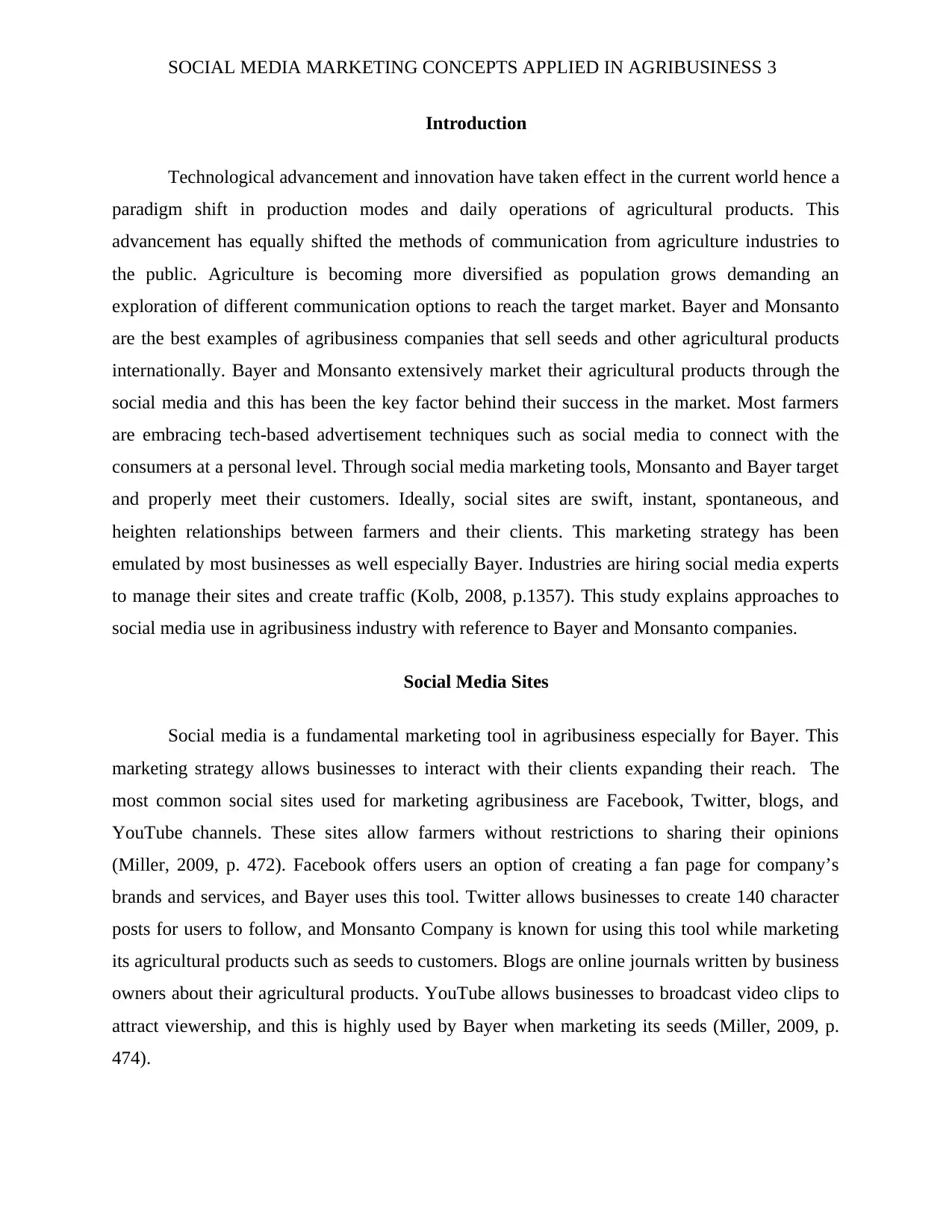
SOCIAL MEDIA MARKETING CONCEPTS APPLIED IN AGRIBUSINESS 3
Introduction
Technological advancement and innovation have taken effect in the current world hence a
paradigm shift in production modes and daily operations of agricultural products. This
advancement has equally shifted the methods of communication from agriculture industries to
the public. Agriculture is becoming more diversified as population grows demanding an
exploration of different communication options to reach the target market. Bayer and Monsanto
are the best examples of agribusiness companies that sell seeds and other agricultural products
internationally. Bayer and Monsanto extensively market their agricultural products through the
social media and this has been the key factor behind their success in the market. Most farmers
are embracing tech-based advertisement techniques such as social media to connect with the
consumers at a personal level. Through social media marketing tools, Monsanto and Bayer target
and properly meet their customers. Ideally, social sites are swift, instant, spontaneous, and
heighten relationships between farmers and their clients. This marketing strategy has been
emulated by most businesses as well especially Bayer. Industries are hiring social media experts
to manage their sites and create traffic (Kolb, 2008, p.1357). This study explains approaches to
social media use in agribusiness industry with reference to Bayer and Monsanto companies.
Social Media Sites
Social media is a fundamental marketing tool in agribusiness especially for Bayer. This
marketing strategy allows businesses to interact with their clients expanding their reach. The
most common social sites used for marketing agribusiness are Facebook, Twitter, blogs, and
YouTube channels. These sites allow farmers without restrictions to sharing their opinions
(Miller, 2009, p. 472). Facebook offers users an option of creating a fan page for company’s
brands and services, and Bayer uses this tool. Twitter allows businesses to create 140 character
posts for users to follow, and Monsanto Company is known for using this tool while marketing
its agricultural products such as seeds to customers. Blogs are online journals written by business
owners about their agricultural products. YouTube allows businesses to broadcast video clips to
attract viewership, and this is highly used by Bayer when marketing its seeds (Miller, 2009, p.
474).
Introduction
Technological advancement and innovation have taken effect in the current world hence a
paradigm shift in production modes and daily operations of agricultural products. This
advancement has equally shifted the methods of communication from agriculture industries to
the public. Agriculture is becoming more diversified as population grows demanding an
exploration of different communication options to reach the target market. Bayer and Monsanto
are the best examples of agribusiness companies that sell seeds and other agricultural products
internationally. Bayer and Monsanto extensively market their agricultural products through the
social media and this has been the key factor behind their success in the market. Most farmers
are embracing tech-based advertisement techniques such as social media to connect with the
consumers at a personal level. Through social media marketing tools, Monsanto and Bayer target
and properly meet their customers. Ideally, social sites are swift, instant, spontaneous, and
heighten relationships between farmers and their clients. This marketing strategy has been
emulated by most businesses as well especially Bayer. Industries are hiring social media experts
to manage their sites and create traffic (Kolb, 2008, p.1357). This study explains approaches to
social media use in agribusiness industry with reference to Bayer and Monsanto companies.
Social Media Sites
Social media is a fundamental marketing tool in agribusiness especially for Bayer. This
marketing strategy allows businesses to interact with their clients expanding their reach. The
most common social sites used for marketing agribusiness are Facebook, Twitter, blogs, and
YouTube channels. These sites allow farmers without restrictions to sharing their opinions
(Miller, 2009, p. 472). Facebook offers users an option of creating a fan page for company’s
brands and services, and Bayer uses this tool. Twitter allows businesses to create 140 character
posts for users to follow, and Monsanto Company is known for using this tool while marketing
its agricultural products such as seeds to customers. Blogs are online journals written by business
owners about their agricultural products. YouTube allows businesses to broadcast video clips to
attract viewership, and this is highly used by Bayer when marketing its seeds (Miller, 2009, p.
474).
⊘ This is a preview!⊘
Do you want full access?
Subscribe today to unlock all pages.

Trusted by 1+ million students worldwide
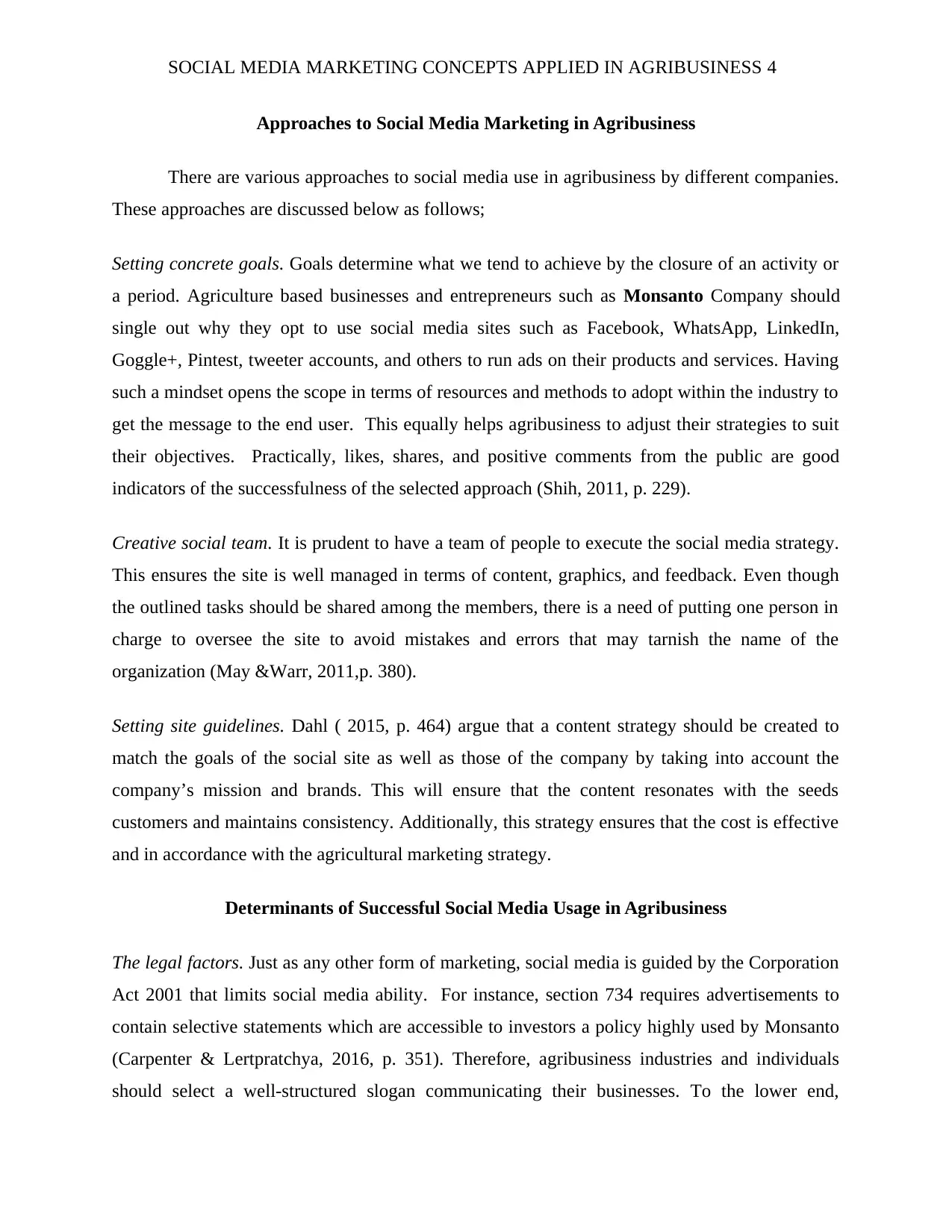
SOCIAL MEDIA MARKETING CONCEPTS APPLIED IN AGRIBUSINESS 4
Approaches to Social Media Marketing in Agribusiness
There are various approaches to social media use in agribusiness by different companies.
These approaches are discussed below as follows;
Setting concrete goals. Goals determine what we tend to achieve by the closure of an activity or
a period. Agriculture based businesses and entrepreneurs such as Monsanto Company should
single out why they opt to use social media sites such as Facebook, WhatsApp, LinkedIn,
Goggle+, Pintest, tweeter accounts, and others to run ads on their products and services. Having
such a mindset opens the scope in terms of resources and methods to adopt within the industry to
get the message to the end user. This equally helps agribusiness to adjust their strategies to suit
their objectives. Practically, likes, shares, and positive comments from the public are good
indicators of the successfulness of the selected approach (Shih, 2011, p. 229).
Creative social team. It is prudent to have a team of people to execute the social media strategy.
This ensures the site is well managed in terms of content, graphics, and feedback. Even though
the outlined tasks should be shared among the members, there is a need of putting one person in
charge to oversee the site to avoid mistakes and errors that may tarnish the name of the
organization (May &Warr, 2011,p. 380).
Setting site guidelines. Dahl ( 2015, p. 464) argue that a content strategy should be created to
match the goals of the social site as well as those of the company by taking into account the
company’s mission and brands. This will ensure that the content resonates with the seeds
customers and maintains consistency. Additionally, this strategy ensures that the cost is effective
and in accordance with the agricultural marketing strategy.
Determinants of Successful Social Media Usage in Agribusiness
The legal factors. Just as any other form of marketing, social media is guided by the Corporation
Act 2001 that limits social media ability. For instance, section 734 requires advertisements to
contain selective statements which are accessible to investors a policy highly used by Monsanto
(Carpenter & Lertpratchya, 2016, p. 351). Therefore, agribusiness industries and individuals
should select a well-structured slogan communicating their businesses. To the lower end,
Approaches to Social Media Marketing in Agribusiness
There are various approaches to social media use in agribusiness by different companies.
These approaches are discussed below as follows;
Setting concrete goals. Goals determine what we tend to achieve by the closure of an activity or
a period. Agriculture based businesses and entrepreneurs such as Monsanto Company should
single out why they opt to use social media sites such as Facebook, WhatsApp, LinkedIn,
Goggle+, Pintest, tweeter accounts, and others to run ads on their products and services. Having
such a mindset opens the scope in terms of resources and methods to adopt within the industry to
get the message to the end user. This equally helps agribusiness to adjust their strategies to suit
their objectives. Practically, likes, shares, and positive comments from the public are good
indicators of the successfulness of the selected approach (Shih, 2011, p. 229).
Creative social team. It is prudent to have a team of people to execute the social media strategy.
This ensures the site is well managed in terms of content, graphics, and feedback. Even though
the outlined tasks should be shared among the members, there is a need of putting one person in
charge to oversee the site to avoid mistakes and errors that may tarnish the name of the
organization (May &Warr, 2011,p. 380).
Setting site guidelines. Dahl ( 2015, p. 464) argue that a content strategy should be created to
match the goals of the social site as well as those of the company by taking into account the
company’s mission and brands. This will ensure that the content resonates with the seeds
customers and maintains consistency. Additionally, this strategy ensures that the cost is effective
and in accordance with the agricultural marketing strategy.
Determinants of Successful Social Media Usage in Agribusiness
The legal factors. Just as any other form of marketing, social media is guided by the Corporation
Act 2001 that limits social media ability. For instance, section 734 requires advertisements to
contain selective statements which are accessible to investors a policy highly used by Monsanto
(Carpenter & Lertpratchya, 2016, p. 351). Therefore, agribusiness industries and individuals
should select a well-structured slogan communicating their businesses. To the lower end,
Paraphrase This Document
Need a fresh take? Get an instant paraphrase of this document with our AI Paraphraser
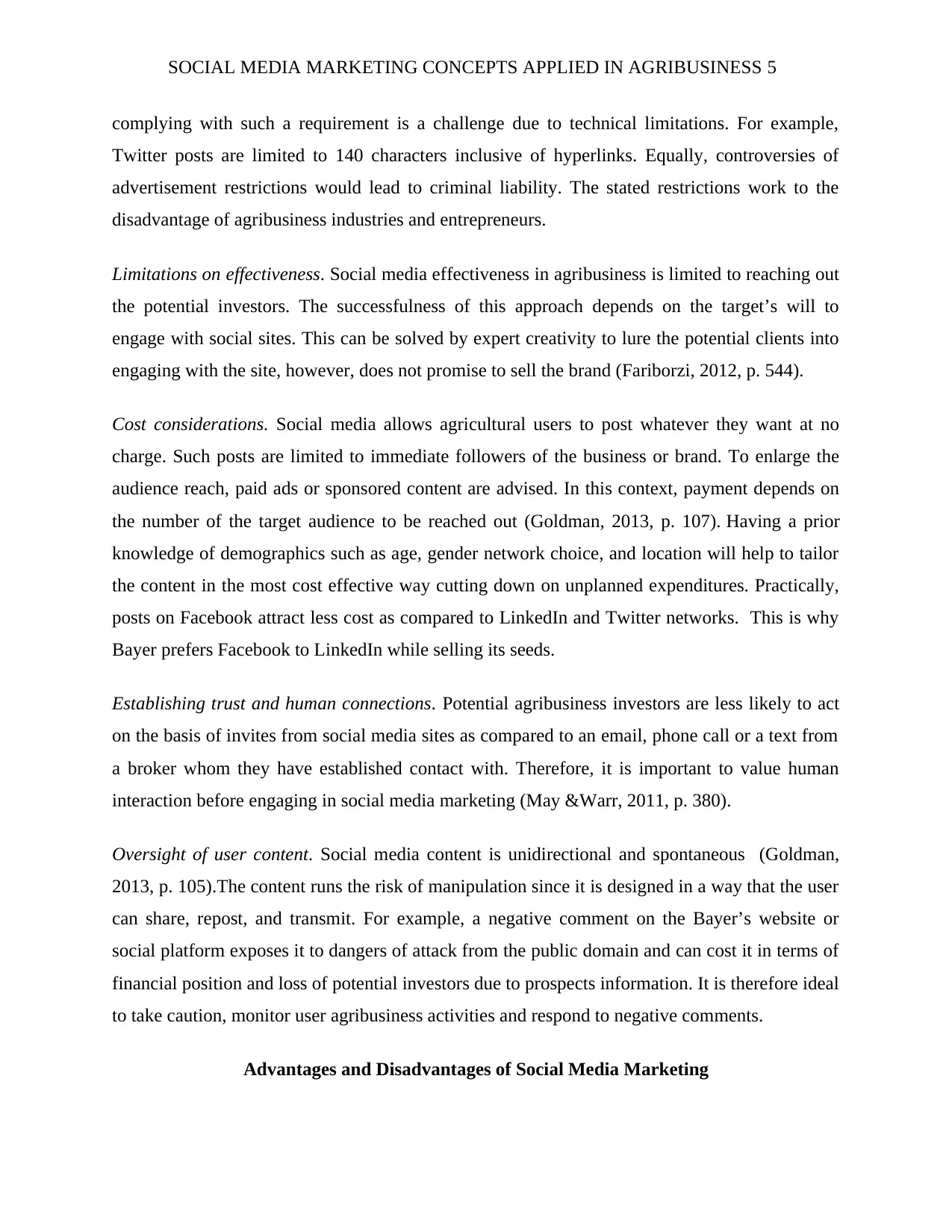
SOCIAL MEDIA MARKETING CONCEPTS APPLIED IN AGRIBUSINESS 5
complying with such a requirement is a challenge due to technical limitations. For example,
Twitter posts are limited to 140 characters inclusive of hyperlinks. Equally, controversies of
advertisement restrictions would lead to criminal liability. The stated restrictions work to the
disadvantage of agribusiness industries and entrepreneurs.
Limitations on effectiveness. Social media effectiveness in agribusiness is limited to reaching out
the potential investors. The successfulness of this approach depends on the target’s will to
engage with social sites. This can be solved by expert creativity to lure the potential clients into
engaging with the site, however, does not promise to sell the brand (Fariborzi, 2012, p. 544).
Cost considerations. Social media allows agricultural users to post whatever they want at no
charge. Such posts are limited to immediate followers of the business or brand. To enlarge the
audience reach, paid ads or sponsored content are advised. In this context, payment depends on
the number of the target audience to be reached out (Goldman, 2013, p. 107). Having a prior
knowledge of demographics such as age, gender network choice, and location will help to tailor
the content in the most cost effective way cutting down on unplanned expenditures. Practically,
posts on Facebook attract less cost as compared to LinkedIn and Twitter networks. This is why
Bayer prefers Facebook to LinkedIn while selling its seeds.
Establishing trust and human connections. Potential agribusiness investors are less likely to act
on the basis of invites from social media sites as compared to an email, phone call or a text from
a broker whom they have established contact with. Therefore, it is important to value human
interaction before engaging in social media marketing (May &Warr, 2011, p. 380).
Oversight of user content. Social media content is unidirectional and spontaneous (Goldman,
2013, p. 105).The content runs the risk of manipulation since it is designed in a way that the user
can share, repost, and transmit. For example, a negative comment on the Bayer’s website or
social platform exposes it to dangers of attack from the public domain and can cost it in terms of
financial position and loss of potential investors due to prospects information. It is therefore ideal
to take caution, monitor user agribusiness activities and respond to negative comments.
Advantages and Disadvantages of Social Media Marketing
complying with such a requirement is a challenge due to technical limitations. For example,
Twitter posts are limited to 140 characters inclusive of hyperlinks. Equally, controversies of
advertisement restrictions would lead to criminal liability. The stated restrictions work to the
disadvantage of agribusiness industries and entrepreneurs.
Limitations on effectiveness. Social media effectiveness in agribusiness is limited to reaching out
the potential investors. The successfulness of this approach depends on the target’s will to
engage with social sites. This can be solved by expert creativity to lure the potential clients into
engaging with the site, however, does not promise to sell the brand (Fariborzi, 2012, p. 544).
Cost considerations. Social media allows agricultural users to post whatever they want at no
charge. Such posts are limited to immediate followers of the business or brand. To enlarge the
audience reach, paid ads or sponsored content are advised. In this context, payment depends on
the number of the target audience to be reached out (Goldman, 2013, p. 107). Having a prior
knowledge of demographics such as age, gender network choice, and location will help to tailor
the content in the most cost effective way cutting down on unplanned expenditures. Practically,
posts on Facebook attract less cost as compared to LinkedIn and Twitter networks. This is why
Bayer prefers Facebook to LinkedIn while selling its seeds.
Establishing trust and human connections. Potential agribusiness investors are less likely to act
on the basis of invites from social media sites as compared to an email, phone call or a text from
a broker whom they have established contact with. Therefore, it is important to value human
interaction before engaging in social media marketing (May &Warr, 2011, p. 380).
Oversight of user content. Social media content is unidirectional and spontaneous (Goldman,
2013, p. 105).The content runs the risk of manipulation since it is designed in a way that the user
can share, repost, and transmit. For example, a negative comment on the Bayer’s website or
social platform exposes it to dangers of attack from the public domain and can cost it in terms of
financial position and loss of potential investors due to prospects information. It is therefore ideal
to take caution, monitor user agribusiness activities and respond to negative comments.
Advantages and Disadvantages of Social Media Marketing

SOCIAL MEDIA MARKETING CONCEPTS APPLIED IN AGRIBUSINESS 6
Social Media Marketing Advantages
Large audiences reach. Social media sites such as Facebook, Twitter, Instagram and
Pinterest command a huge audience. Specifically, Facebook and Twitter accounts have
approximately 350 million users, Instagram has 500 million, and Pinterest has 110 million
(Fariborzi, 2012, p. 542). This audience may work for the good of agribusiness by attracting
more clients hence a huge profit margin as well as market globally.
Free creation. Social media marketing is entirely free to start. There is no start-up fee
charged therefore agribusiness industries, and persons will only incur costs linked to time and
labor. However, there are paid ads to increase audience reach though not a requirement for
establishing a social site to run business operations (Dahl, 2015, p. 464).
Encourages sharing. Contents, ads, photos, recipes, quotes, slogans, ideas, among other
elements posted on social media sites allow users to share to other networks and individual
connections (Kolb, 2008, p.1357). This allows viral spreading of the communication set by the
business.
Increased brand loyalty. Social media does not only increase reach but also brand loyalty.
Followers who express interest in a brand shared over social sites are more likely to create a
strong brand loyalty that is unshakable (Schneider, 2010, p. 66). Practically, this approach works
on two-way communication terms where the customers can express their expectations and the
agribusiness industry, or individuals address these expectations. For instance, a strong
relationship has got created between Bayer’s clients and the business hence increasing the
confidence in clients’ decision towards the business agricultural products at present and in future.
Unveils valuable insights. Since social sites are communication tools, valuable
information about customers is obtained there. With such information, businesses are likely to
act upon the highlighted areas and make smarter business decisions. For example, customers’
views on agricultural products can influence agricultural based industries to restructure their
modes of production, service delivery, packaging and design among other factors. It is a platform
for evaluating how people think about the business and establishing methods of improvement to
better their needs hence a mutual co-existence (Schneider, n.d., p. 67).
Social Media Marketing Advantages
Large audiences reach. Social media sites such as Facebook, Twitter, Instagram and
Pinterest command a huge audience. Specifically, Facebook and Twitter accounts have
approximately 350 million users, Instagram has 500 million, and Pinterest has 110 million
(Fariborzi, 2012, p. 542). This audience may work for the good of agribusiness by attracting
more clients hence a huge profit margin as well as market globally.
Free creation. Social media marketing is entirely free to start. There is no start-up fee
charged therefore agribusiness industries, and persons will only incur costs linked to time and
labor. However, there are paid ads to increase audience reach though not a requirement for
establishing a social site to run business operations (Dahl, 2015, p. 464).
Encourages sharing. Contents, ads, photos, recipes, quotes, slogans, ideas, among other
elements posted on social media sites allow users to share to other networks and individual
connections (Kolb, 2008, p.1357). This allows viral spreading of the communication set by the
business.
Increased brand loyalty. Social media does not only increase reach but also brand loyalty.
Followers who express interest in a brand shared over social sites are more likely to create a
strong brand loyalty that is unshakable (Schneider, 2010, p. 66). Practically, this approach works
on two-way communication terms where the customers can express their expectations and the
agribusiness industry, or individuals address these expectations. For instance, a strong
relationship has got created between Bayer’s clients and the business hence increasing the
confidence in clients’ decision towards the business agricultural products at present and in future.
Unveils valuable insights. Since social sites are communication tools, valuable
information about customers is obtained there. With such information, businesses are likely to
act upon the highlighted areas and make smarter business decisions. For example, customers’
views on agricultural products can influence agricultural based industries to restructure their
modes of production, service delivery, packaging and design among other factors. It is a platform
for evaluating how people think about the business and establishing methods of improvement to
better their needs hence a mutual co-existence (Schneider, n.d., p. 67).
⊘ This is a preview!⊘
Do you want full access?
Subscribe today to unlock all pages.

Trusted by 1+ million students worldwide
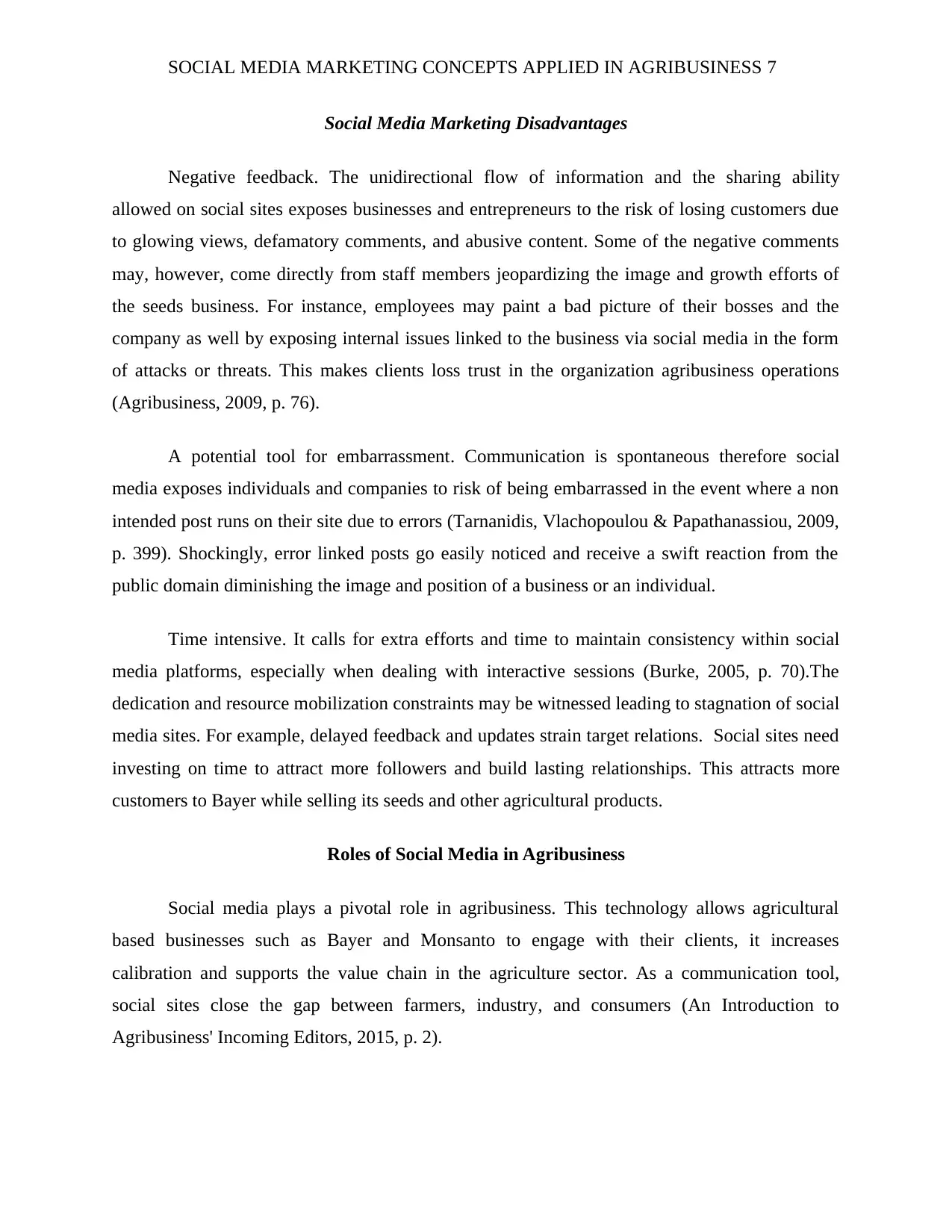
SOCIAL MEDIA MARKETING CONCEPTS APPLIED IN AGRIBUSINESS 7
Social Media Marketing Disadvantages
Negative feedback. The unidirectional flow of information and the sharing ability
allowed on social sites exposes businesses and entrepreneurs to the risk of losing customers due
to glowing views, defamatory comments, and abusive content. Some of the negative comments
may, however, come directly from staff members jeopardizing the image and growth efforts of
the seeds business. For instance, employees may paint a bad picture of their bosses and the
company as well by exposing internal issues linked to the business via social media in the form
of attacks or threats. This makes clients loss trust in the organization agribusiness operations
(Agribusiness, 2009, p. 76).
A potential tool for embarrassment. Communication is spontaneous therefore social
media exposes individuals and companies to risk of being embarrassed in the event where a non
intended post runs on their site due to errors (Tarnanidis, Vlachopoulou & Papathanassiou, 2009,
p. 399). Shockingly, error linked posts go easily noticed and receive a swift reaction from the
public domain diminishing the image and position of a business or an individual.
Time intensive. It calls for extra efforts and time to maintain consistency within social
media platforms, especially when dealing with interactive sessions (Burke, 2005, p. 70).The
dedication and resource mobilization constraints may be witnessed leading to stagnation of social
media sites. For example, delayed feedback and updates strain target relations. Social sites need
investing on time to attract more followers and build lasting relationships. This attracts more
customers to Bayer while selling its seeds and other agricultural products.
Roles of Social Media in Agribusiness
Social media plays a pivotal role in agribusiness. This technology allows agricultural
based businesses such as Bayer and Monsanto to engage with their clients, it increases
calibration and supports the value chain in the agriculture sector. As a communication tool,
social sites close the gap between farmers, industry, and consumers (An Introduction to
Agribusiness' Incoming Editors, 2015, p. 2).
Social Media Marketing Disadvantages
Negative feedback. The unidirectional flow of information and the sharing ability
allowed on social sites exposes businesses and entrepreneurs to the risk of losing customers due
to glowing views, defamatory comments, and abusive content. Some of the negative comments
may, however, come directly from staff members jeopardizing the image and growth efforts of
the seeds business. For instance, employees may paint a bad picture of their bosses and the
company as well by exposing internal issues linked to the business via social media in the form
of attacks or threats. This makes clients loss trust in the organization agribusiness operations
(Agribusiness, 2009, p. 76).
A potential tool for embarrassment. Communication is spontaneous therefore social
media exposes individuals and companies to risk of being embarrassed in the event where a non
intended post runs on their site due to errors (Tarnanidis, Vlachopoulou & Papathanassiou, 2009,
p. 399). Shockingly, error linked posts go easily noticed and receive a swift reaction from the
public domain diminishing the image and position of a business or an individual.
Time intensive. It calls for extra efforts and time to maintain consistency within social
media platforms, especially when dealing with interactive sessions (Burke, 2005, p. 70).The
dedication and resource mobilization constraints may be witnessed leading to stagnation of social
media sites. For example, delayed feedback and updates strain target relations. Social sites need
investing on time to attract more followers and build lasting relationships. This attracts more
customers to Bayer while selling its seeds and other agricultural products.
Roles of Social Media in Agribusiness
Social media plays a pivotal role in agribusiness. This technology allows agricultural
based businesses such as Bayer and Monsanto to engage with their clients, it increases
calibration and supports the value chain in the agriculture sector. As a communication tool,
social sites close the gap between farmers, industry, and consumers (An Introduction to
Agribusiness' Incoming Editors, 2015, p. 2).
Paraphrase This Document
Need a fresh take? Get an instant paraphrase of this document with our AI Paraphraser
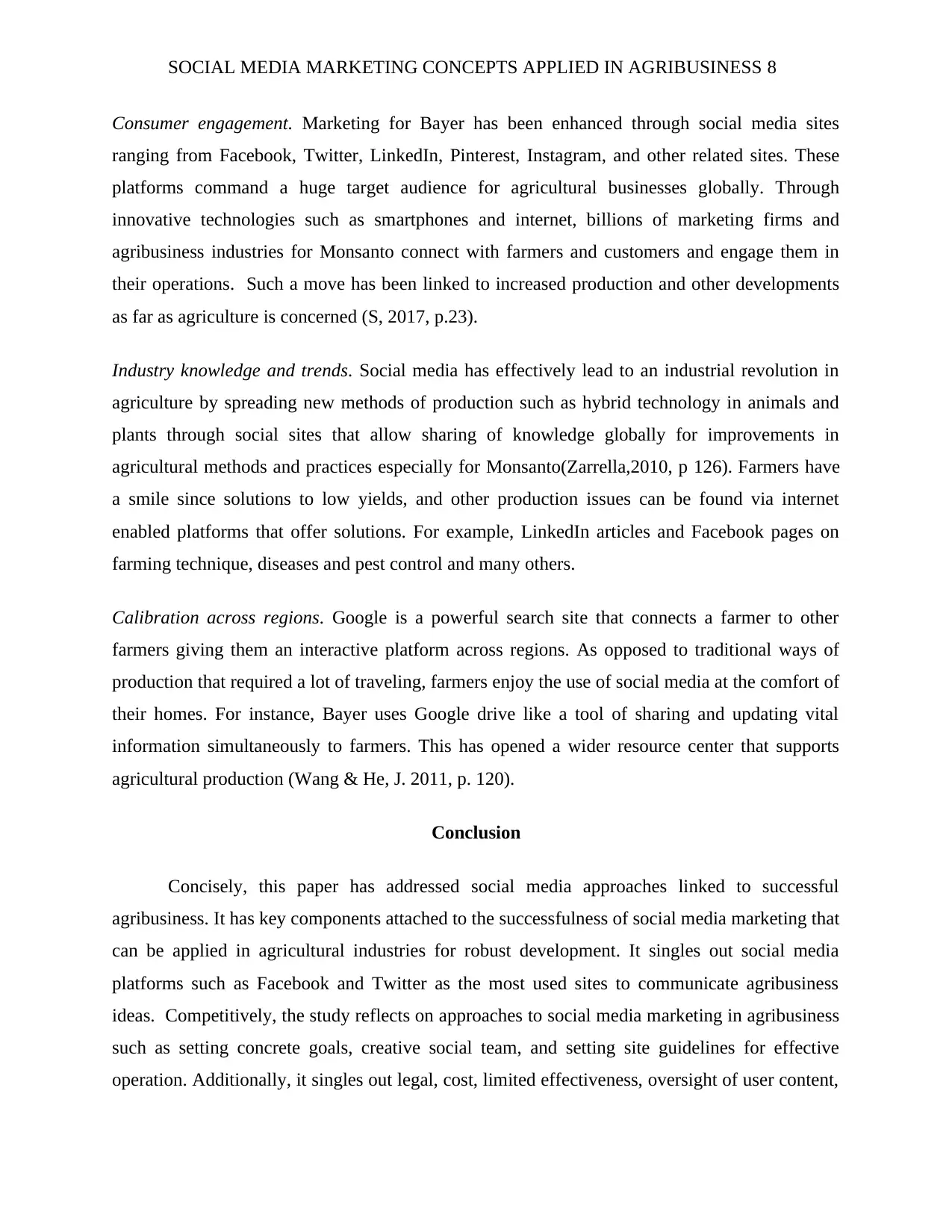
SOCIAL MEDIA MARKETING CONCEPTS APPLIED IN AGRIBUSINESS 8
Consumer engagement. Marketing for Bayer has been enhanced through social media sites
ranging from Facebook, Twitter, LinkedIn, Pinterest, Instagram, and other related sites. These
platforms command a huge target audience for agricultural businesses globally. Through
innovative technologies such as smartphones and internet, billions of marketing firms and
agribusiness industries for Monsanto connect with farmers and customers and engage them in
their operations. Such a move has been linked to increased production and other developments
as far as agriculture is concerned (S, 2017, p.23).
Industry knowledge and trends. Social media has effectively lead to an industrial revolution in
agriculture by spreading new methods of production such as hybrid technology in animals and
plants through social sites that allow sharing of knowledge globally for improvements in
agricultural methods and practices especially for Monsanto(Zarrella,2010, p 126). Farmers have
a smile since solutions to low yields, and other production issues can be found via internet
enabled platforms that offer solutions. For example, LinkedIn articles and Facebook pages on
farming technique, diseases and pest control and many others.
Calibration across regions. Google is a powerful search site that connects a farmer to other
farmers giving them an interactive platform across regions. As opposed to traditional ways of
production that required a lot of traveling, farmers enjoy the use of social media at the comfort of
their homes. For instance, Bayer uses Google drive like a tool of sharing and updating vital
information simultaneously to farmers. This has opened a wider resource center that supports
agricultural production (Wang & He, J. 2011, p. 120).
Conclusion
Concisely, this paper has addressed social media approaches linked to successful
agribusiness. It has key components attached to the successfulness of social media marketing that
can be applied in agricultural industries for robust development. It singles out social media
platforms such as Facebook and Twitter as the most used sites to communicate agribusiness
ideas. Competitively, the study reflects on approaches to social media marketing in agribusiness
such as setting concrete goals, creative social team, and setting site guidelines for effective
operation. Additionally, it singles out legal, cost, limited effectiveness, oversight of user content,
Consumer engagement. Marketing for Bayer has been enhanced through social media sites
ranging from Facebook, Twitter, LinkedIn, Pinterest, Instagram, and other related sites. These
platforms command a huge target audience for agricultural businesses globally. Through
innovative technologies such as smartphones and internet, billions of marketing firms and
agribusiness industries for Monsanto connect with farmers and customers and engage them in
their operations. Such a move has been linked to increased production and other developments
as far as agriculture is concerned (S, 2017, p.23).
Industry knowledge and trends. Social media has effectively lead to an industrial revolution in
agriculture by spreading new methods of production such as hybrid technology in animals and
plants through social sites that allow sharing of knowledge globally for improvements in
agricultural methods and practices especially for Monsanto(Zarrella,2010, p 126). Farmers have
a smile since solutions to low yields, and other production issues can be found via internet
enabled platforms that offer solutions. For example, LinkedIn articles and Facebook pages on
farming technique, diseases and pest control and many others.
Calibration across regions. Google is a powerful search site that connects a farmer to other
farmers giving them an interactive platform across regions. As opposed to traditional ways of
production that required a lot of traveling, farmers enjoy the use of social media at the comfort of
their homes. For instance, Bayer uses Google drive like a tool of sharing and updating vital
information simultaneously to farmers. This has opened a wider resource center that supports
agricultural production (Wang & He, J. 2011, p. 120).
Conclusion
Concisely, this paper has addressed social media approaches linked to successful
agribusiness. It has key components attached to the successfulness of social media marketing that
can be applied in agricultural industries for robust development. It singles out social media
platforms such as Facebook and Twitter as the most used sites to communicate agribusiness
ideas. Competitively, the study reflects on approaches to social media marketing in agribusiness
such as setting concrete goals, creative social team, and setting site guidelines for effective
operation. Additionally, it singles out legal, cost, limited effectiveness, oversight of user content,
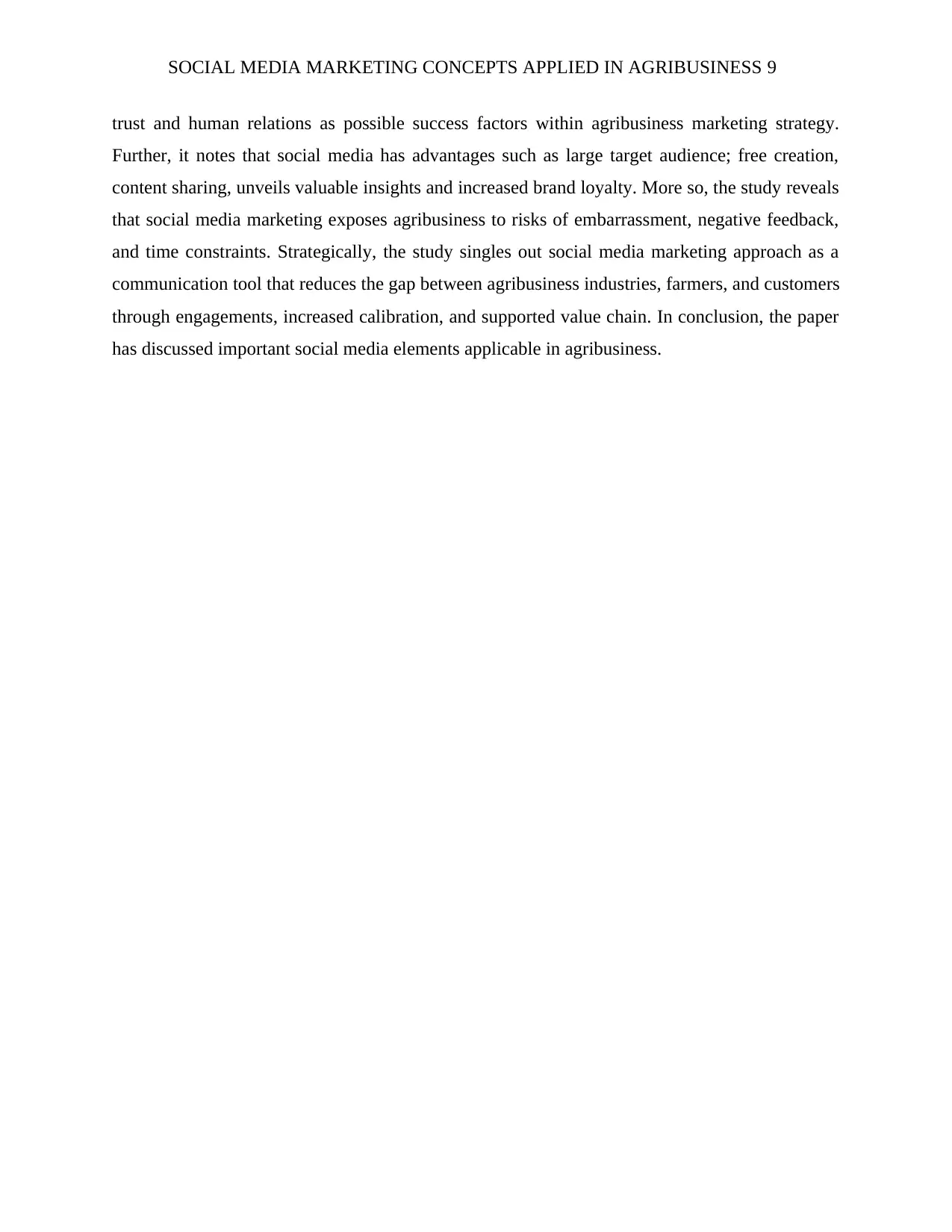
SOCIAL MEDIA MARKETING CONCEPTS APPLIED IN AGRIBUSINESS 9
trust and human relations as possible success factors within agribusiness marketing strategy.
Further, it notes that social media has advantages such as large target audience; free creation,
content sharing, unveils valuable insights and increased brand loyalty. More so, the study reveals
that social media marketing exposes agribusiness to risks of embarrassment, negative feedback,
and time constraints. Strategically, the study singles out social media marketing approach as a
communication tool that reduces the gap between agribusiness industries, farmers, and customers
through engagements, increased calibration, and supported value chain. In conclusion, the paper
has discussed important social media elements applicable in agribusiness.
trust and human relations as possible success factors within agribusiness marketing strategy.
Further, it notes that social media has advantages such as large target audience; free creation,
content sharing, unveils valuable insights and increased brand loyalty. More so, the study reveals
that social media marketing exposes agribusiness to risks of embarrassment, negative feedback,
and time constraints. Strategically, the study singles out social media marketing approach as a
communication tool that reduces the gap between agribusiness industries, farmers, and customers
through engagements, increased calibration, and supported value chain. In conclusion, the paper
has discussed important social media elements applicable in agribusiness.
⊘ This is a preview!⊘
Do you want full access?
Subscribe today to unlock all pages.

Trusted by 1+ million students worldwide
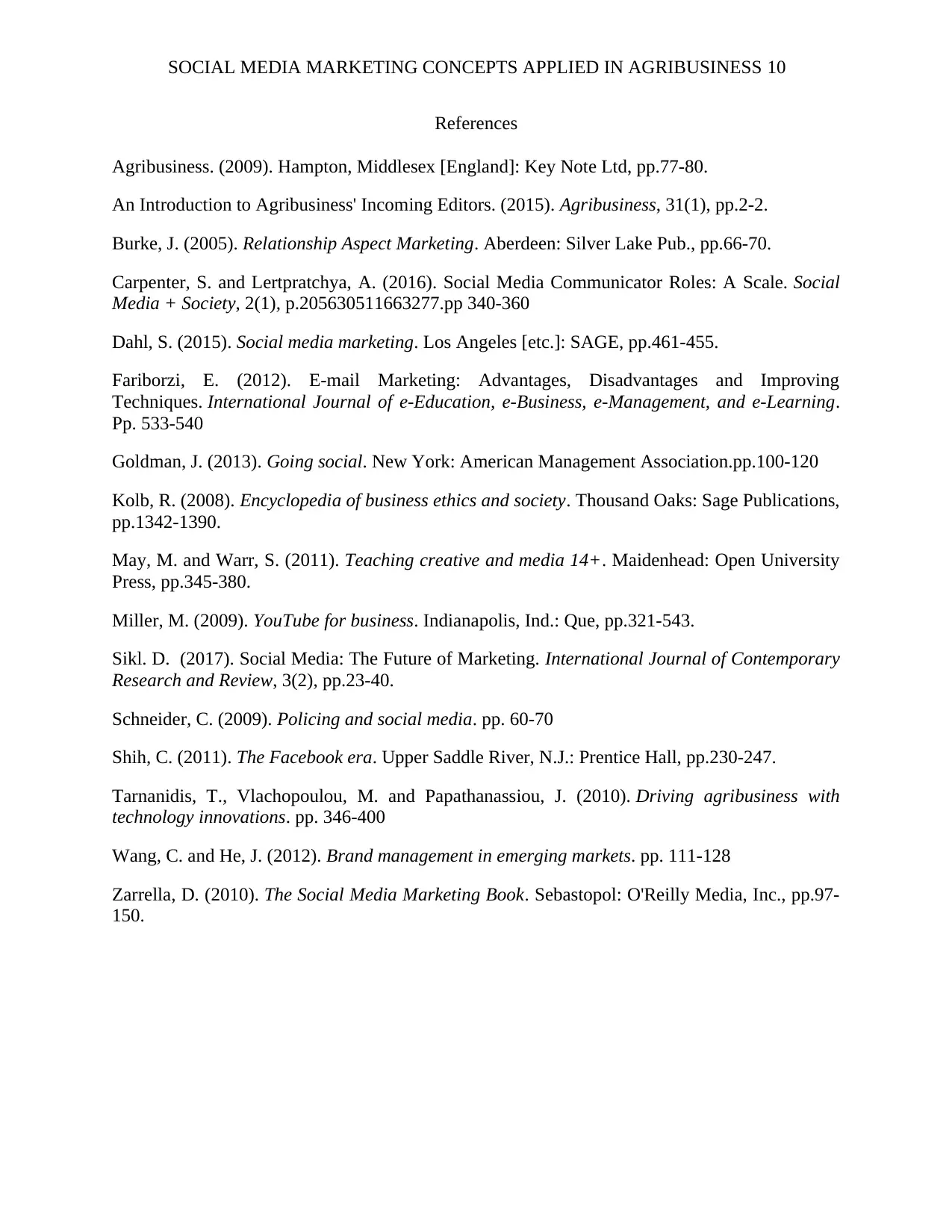
SOCIAL MEDIA MARKETING CONCEPTS APPLIED IN AGRIBUSINESS 10
References
Agribusiness. (2009). Hampton, Middlesex [England]: Key Note Ltd, pp.77-80.
An Introduction to Agribusiness' Incoming Editors. (2015). Agribusiness, 31(1), pp.2-2.
Burke, J. (2005). Relationship Aspect Marketing. Aberdeen: Silver Lake Pub., pp.66-70.
Carpenter, S. and Lertpratchya, A. (2016). Social Media Communicator Roles: A Scale. Social
Media + Society, 2(1), p.205630511663277.pp 340-360
Dahl, S. (2015). Social media marketing. Los Angeles [etc.]: SAGE, pp.461-455.
Fariborzi, E. (2012). E-mail Marketing: Advantages, Disadvantages and Improving
Techniques. International Journal of e-Education, e-Business, e-Management, and e-Learning.
Pp. 533-540
Goldman, J. (2013). Going social. New York: American Management Association.pp.100-120
Kolb, R. (2008). Encyclopedia of business ethics and society. Thousand Oaks: Sage Publications,
pp.1342-1390.
May, M. and Warr, S. (2011). Teaching creative and media 14+. Maidenhead: Open University
Press, pp.345-380.
Miller, M. (2009). YouTube for business. Indianapolis, Ind.: Que, pp.321-543.
Sikl. D. (2017). Social Media: The Future of Marketing. International Journal of Contemporary
Research and Review, 3(2), pp.23-40.
Schneider, C. (2009). Policing and social media. pp. 60-70
Shih, C. (2011). The Facebook era. Upper Saddle River, N.J.: Prentice Hall, pp.230-247.
Tarnanidis, T., Vlachopoulou, M. and Papathanassiou, J. (2010). Driving agribusiness with
technology innovations. pp. 346-400
Wang, C. and He, J. (2012). Brand management in emerging markets. pp. 111-128
Zarrella, D. (2010). The Social Media Marketing Book. Sebastopol: O'Reilly Media, Inc., pp.97-
150.
References
Agribusiness. (2009). Hampton, Middlesex [England]: Key Note Ltd, pp.77-80.
An Introduction to Agribusiness' Incoming Editors. (2015). Agribusiness, 31(1), pp.2-2.
Burke, J. (2005). Relationship Aspect Marketing. Aberdeen: Silver Lake Pub., pp.66-70.
Carpenter, S. and Lertpratchya, A. (2016). Social Media Communicator Roles: A Scale. Social
Media + Society, 2(1), p.205630511663277.pp 340-360
Dahl, S. (2015). Social media marketing. Los Angeles [etc.]: SAGE, pp.461-455.
Fariborzi, E. (2012). E-mail Marketing: Advantages, Disadvantages and Improving
Techniques. International Journal of e-Education, e-Business, e-Management, and e-Learning.
Pp. 533-540
Goldman, J. (2013). Going social. New York: American Management Association.pp.100-120
Kolb, R. (2008). Encyclopedia of business ethics and society. Thousand Oaks: Sage Publications,
pp.1342-1390.
May, M. and Warr, S. (2011). Teaching creative and media 14+. Maidenhead: Open University
Press, pp.345-380.
Miller, M. (2009). YouTube for business. Indianapolis, Ind.: Que, pp.321-543.
Sikl. D. (2017). Social Media: The Future of Marketing. International Journal of Contemporary
Research and Review, 3(2), pp.23-40.
Schneider, C. (2009). Policing and social media. pp. 60-70
Shih, C. (2011). The Facebook era. Upper Saddle River, N.J.: Prentice Hall, pp.230-247.
Tarnanidis, T., Vlachopoulou, M. and Papathanassiou, J. (2010). Driving agribusiness with
technology innovations. pp. 346-400
Wang, C. and He, J. (2012). Brand management in emerging markets. pp. 111-128
Zarrella, D. (2010). The Social Media Marketing Book. Sebastopol: O'Reilly Media, Inc., pp.97-
150.
1 out of 10
Related Documents
Your All-in-One AI-Powered Toolkit for Academic Success.
+13062052269
info@desklib.com
Available 24*7 on WhatsApp / Email
![[object Object]](/_next/static/media/star-bottom.7253800d.svg)
Unlock your academic potential
Copyright © 2020–2025 A2Z Services. All Rights Reserved. Developed and managed by ZUCOL.





